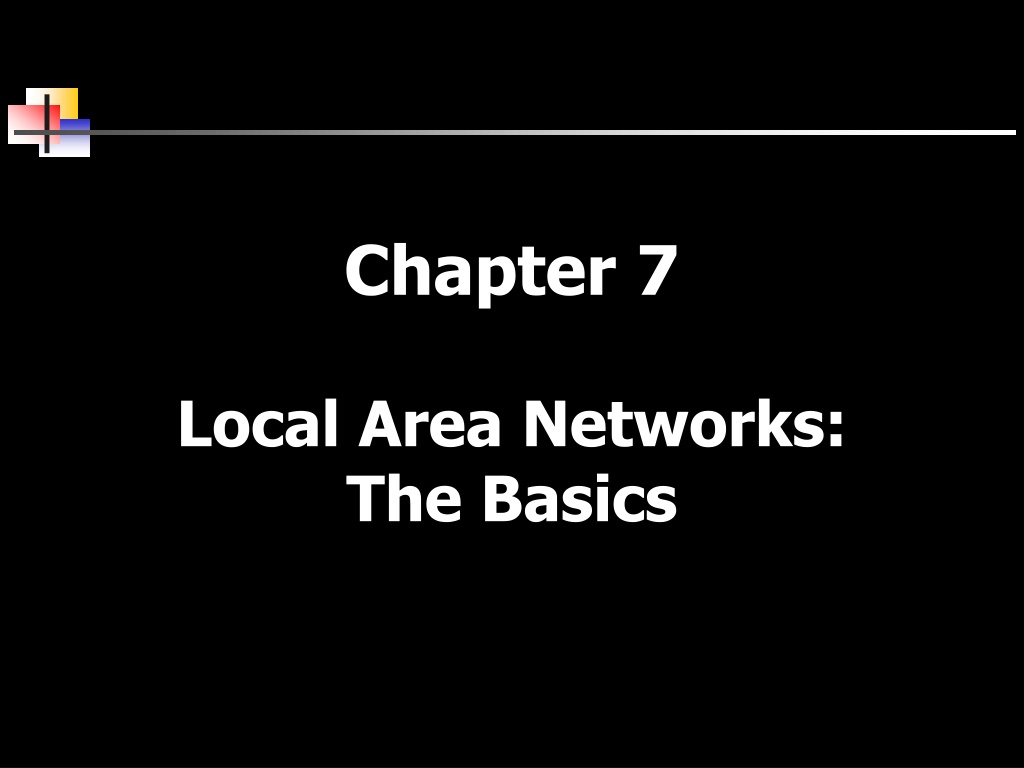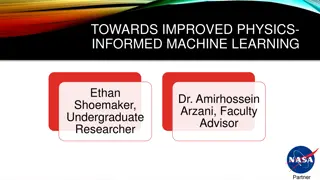Understanding Local Area Networks: Basics, Advantages, and Disadvantages
A Local Area Network (LAN) serves various functions such as file serving, print serving, video transfers, and more. LANs offer advantages like resource sharing, private ownership, and secure transfers, but come with disadvantages such as costliness and maintenance issues. Different LAN topologies like Bus/Tree and Star-wired Bus are explained, highlighting baseband and broadband signals. Explore the pros and cons of LAN technology to better grasp its impact on networking solutions.
Download Presentation

Please find below an Image/Link to download the presentation.
The content on the website is provided AS IS for your information and personal use only. It may not be sold, licensed, or shared on other websites without obtaining consent from the author. Download presentation by click this link. If you encounter any issues during the download, it is possible that the publisher has removed the file from their server.
E N D
Presentation Transcript
Chapter 7 Local Area Networks: The Basics
Primary Function of a LAN File serving large storage disk drive acts as a central storage repository Print serving Providing authorization to access a particular printer, accept and queue print jobs, and user access to print queue to perform administrative duties Video transfers High speed LANs are capable of supporting video image and live video transfers Manufacturing support LANs can support manufacturing and industrial environments Academic support In classrooms, labs, and wireless E-mail support Interconnection between multiple systems 2
Advantages of LAN Ability to share hardware and software resources Individual workstation might survive network failure Component and system evolution are possible Support for heterogeneous forms of hardware and software Access to other LANs and WANs Private ownership Secure transfers at high speeds with low error rates 3
Disadvantages of LAN Equipment and support can be costly Level of maintenance continues to grow Private ownership? Some types of hardware may not interoperate Just because a LAN can support two different kinds of packages does not mean their data can interchange easily A LAN is only as strong as it weakest link, and there are many links 4
Basic LAN Topologies Bus/tree Star-wired bus Star-wired ring Wireless 5
Bus/Tree Topology The original topology. Workstation has a network interface card (NIC) that attaches to the bus (a coaxial cable) via a tap. Data can be transferred using either baseband digital signals or broadband analog signals. Baseband signals are bidirectional (broadcast) and move outward in both directions from the workstation transmitting. Broadband signals are usually uni-directional and transmit in only one direction. Because of this, special wiring considerations are necessary. Buses can be split and joined, creating trees. 6
Baseband Broadband 7
Star-wired Bus Topology Logically operates as a bus, but physically looks like a star Star design is based on hub. All workstations attach to hub Unshielded twisted pair usually used to connect workstation to hub Hub takes incoming signal and immediately broadcasts it out all connected links Hubs can be interconnected to extend network size Modular connectors and twisted pair make installation and maintenance of star-wired bus better than standard bus Hubs can be interconnected with twisted pair, coaxial cable, or fiber optic cable Biggest disadvantage: when one station talks, everyone hears it. This is called a shared network. All devices are sharing the network medium 8
Star-wired Ring Topology Logically operates as a ring but physically appears as a star Based on MAU (multi-station access unit) which functions similarly to a hub Where a hub immediately broadcasts all incoming signals onto all connected links, the MAU passes the signal around in a ring fashion Like hubs, MAUs can be interconnected to increase network size 10
Wireless LANs (I) Not really a specific topology Workstation in wireless LAN can be anywhere as long as within transmitting distance to access point Several versions of IEEE 802.11 standard defines various forms of wireless LAN connections Two basic components necessary: Client Radio - usually PC card with integrated antenna installed in a laptop or workstation Access Point (AP) - Ethernet port plus transceiver AP acts as bridge between wired and wireless networks Can perform basic routing functions Single-cell - Workstations reside within a basic service set Multiple-cell - Multiple basic service sets create an extended service set Ad-hoc - Wireless LANs configured without access point 12
Wireless LANs (II) IEEE 802.11 The original wireless standard, transmitting data at 2 Mbps IEEE 802.11b The second wireless standard, transmitting data at 11 Mbps IEEE 802.11a One of the more recent standards, transmitting data at 54 Mbps using 5 GHz frequency range IEEE 802.11g The other recent standard, also transmitting data at 54 Mbps but using the same frequencies as 802.11b (2.4 GHz) Backwards compatible with 802.11b IEEE 802.11n (100 Mbps) is last standard that has been widely implemented. Available at both 2.4 & 5 GHz Latest wireless Ethernet is using MIMO technology (multiple input multiple output) Sender and receiver have multiple antennas for optimum reception IEEE 802.11ac is the latest standard that is gaining momentum Operates only on 5 GHz band with data rate up to 6.9 Gbps 14
Medium Access Control Protocols How does a workstation get its data onto the LAN medium? Medium access control protocol - software that allows workstations to take turns at transmitting data Two basic categories: Contention-based protocols Round robin protocols 16
Contention-Based Protocols (I) Essentially first come first served Most common example: Carrier sense multiple access with collision detection (CSMA/CD) If no one is transmitting, a workstation can transmit If someone else is transmitting, workstation backs off and waits If two workstations transmit at same time, collision occurs When two workstations hear collision, they stop transmitting immediately Each workstation backs off a random amount of time and tries again Hopefully, both workstations do not try again at exact same time CSMA/CD is an example of a nondeterministic protocol 17
Contention-Based Protocols (II) Wireless CSMA/CA (Collision avoidance) Protocol does not listen and detect collisions Instead, tries to avoid collisions before they happen How does CSMA/CA do this? All devices, before they transmit, must wait an amount of time called an interframe space (IFS) Some applications have a short IFS, while others have a long IFS If two applications want to transmit at same time, the application with shorter IFS will go first. If medium is idle after IFS, a random backoff counter is selected and transmission starts after the countdown. 19
Round Robin Protocols Each workstation takes turn transmitting: turn is passed around the network from workstation to workstation Most common example is token ring LAN in which a software token is passed from workstation to workstation Token ring is an example of a deterministic protocol Token ring more complex than CSMA/CD What happens if token is lost? Duplicated? Hogged? Token ring LANs are losing the battle with CSMA/CD LANs 20
IEEE 802 To better support local area networks, data link layer of the OSI model was broken into two sublayers: 1. Logical link control sublayer 2. Medium access control sublayer Medium access control sublayer defines the frame layout More closely tied to specific medium at physical layer Thus, when people refer to LANs they often refer to its MAC sublayer name, such as 10BaseT 22
IEEE 802 Frame Formats IEEE 802 suite of protocols defines frame formats for CSMA/CD (IEEE 802.3), CSMA/CA (IEEE 802.11), and token ring (IEEE 802.5) Each frame format describes how data package is formed If a CSMA/CD network connects to a token ring network, frames have to be converted from one to another 23
Frame Formats IEEE 802.3 CSMA/CD IEEE 802.11 CSMA/CA IEEE 802.5 Token Ring 24
LAN Systems Ethernet or CSMA/CD IBM Token Ring FDDI (Fiber Distributed Data Interface) 25
Ethernet Originally, CSMA/CD was 10 Mbps. Then 100 Mbps was introduced. Most NICs sold today are 10/100 Mbps. Then 1000 Mbps (1 Gbps) was introduced. Transmission is full duplex (separate transmit and receive), thus no collisions. Prioritization is possible using 802.1p protocol. Topology can be star or mesh (for trunks). Cabling can be either UTP or optical. Where 10 Mbps Ethernet has less than 30% utilization due to collisions, 1000 Mbps is limited only by traffic queuing. Distance with 10 Mbps is limited by CSMA/CD propagation time, whereas 1000 Mbps is limited only by media. 10 Gbps is now beginning to appear. 26
Power & Ethernet What if you have a remote device that has an Ethernet connection? It will require a power connection What if you don t have an electrical outlet nearby? Use PoE Power to drive Ethernet NIC is sent over wiring along with usual Ethernet signals Ethernet over power line Uses existing power lines in the building No new wiring needed Slower 28
IBM Token Ring Deterministic LAN offered at speeds of 4, 16 and 100 Mbps. Very good throughput under heavy loads. More expensive components than CSMA/CD. Losing ground quickly to CSMA/CD. May be extinct soon. 29
FDDI Based on the token ring design using 100 Mbps fiber connections. Allows for two concentric rings - inner ring can support data travel in opposite direction or work as backup. Token is attached to the outgoing packet, rather than waiting for the outgoing packet to circle the entire ring. 30
Interconnection Necessary to connect a local area network to another local area network or to a wide area network. LAN-to-LAN connections are often performed with a bridge-like device. LAN-to-WAN connections are usually performed with a router. A switch can be used to interconnect segments of a local area network. 31
Why Segment or Interconnect? To separate / connect one corporate division with another To connect two LANs with different protocols To connect a LAN to the Internet To break a LAN into segments to relieve traffic congestion To provide a security wall between two different types of users 32
Hubs Interconnects two or more workstations into a local area network. When a workstation transmits to a hub, the hub immediately resends the data frame out all connecting links. A hub can be managed or unmanaged. A managed hub possesses enough processing power that it can be managed from a remote location. 33
Hub issues Maximum distance between devices (100m in 10Base-T) Must avoid loops between connected hubs message would circulate endlessly Number of devices on network increases collision risks collisions during peak traffic periods can crash the network (200 devices) 34
Bridges Connect two similar LANs, such as two CSMA/CD LANs. Connect two closely similar LANs, such as a CSMA/CD LAN and a token ring LAN. Examines the destination address in a frame and either forwards this frame onto the next LAN or does not. Examines the source address in a frame and places this address in a routing table, to be used for future routing decisions. 35
37 37
Transparent Bridge Does not need programming but observes all traffic and builds routing tables from observation. The observation is called backward learning. Each bridge has two connections (ports) and there is a routing table associated with each port. Observes each frame that arrives at a port, extracts the source address from the frame, and places that address in the port s routing table. Found with CSMA/CD LANs. Can also convert one frame format to another. Sometimes refereed to as a gateway or sometimes a router. Removes the headers and trailers from one frame format and inserts (encapsulates) the headers and trailers for the second frame format. 38
Remote Bridge Passing a data frame from one LAN to another when the two LANs are separated by a long distance and there is a wide area network connecting the two LANs. Takes the frame before it leaves the first LAN and encapsulates the WAN headers and trailers. When the packet arrives at the destination remote bridge, that bridge removes the WAN headers and trailers leaving the original frame. 40
Switches (I) Combination of a hub and a bridge. Can interconnect two or more workstations, but like a bridge, it observes traffic flow and learns. When a frame arrives at a switch, the switch examines the destination address and forwards the frame out the one necessary connection. Workstations that connect to a hub are on a shared segment. Workstations that connect to a switch are on a switched segment. 41
Switches (II) The backplane of a switch is fast enough to support multiple data transfers at one time. A switch that employs cut-through architecture is passing on the frame before the entire frame has arrived at the switch. Multiple workstations connected to a switch use dedicated segments. This is a very efficient way to isolate heavy users from the network. A switch can allow simultaneous access to multiple servers, or multiple simultaneous connections to a single server. Using a pair of routers, it is possible to interconnect to switched segments, essentially creating one large local area network 42
Virtual LANs Logical subgroup within a LAN that is created via switches and software rather than by manually moving wiring from one network device to another Even though employees and their actual computer workstations may be scattered throughout the building, LAN switches and VLAN software can be used to create a network within a network A relatively new standard, IEEE 802.1Q, was designed to allow multiple devices to intercommunicate and work together to create a virtual LAN Instead of sending technician to a wiring closet to move a workstation cable from one switch to another, an 802.1Q-compliant switch can be remotely configured by a network administrator 43
Full Duplex Switches Allows for simultaneous transmission and reception of data to and from a workstation This full duplex connection helps eliminate collisions To support a full duplex connection to a switch, at least two pairs of wires are necessary One for the receive operation One for the transmit operation Most people install four pairs today, so wiring is not problem 44
Link Aggregation Combining multiple physical connection into one logical connection Increase connection speed Fault tolerance IEEE 802.3ad-2000 45
Spanning Tree Algorithm In large network, a loop can be created where a frame can circle through the network and back to the originating device The spanning tree algorithm (used in Spanning Tree Protocol and now Rapid Spanning Tree Protocol) runs in switches and can identify loops and remove them Identify a switch as the root switch Visit each switch and identify the one port (RP) that has the shortest path back to the root switch. Visit each LAN and identify the port (DP) that provides the shortest path back to the root switch. Mark the remaining unidentified ports as Removed in the forwarding tables. 46
Quality of Service (QoS) Set priority for each frame The 802.1p adds a 3-bit field (PCP) to each Ethernet frame PCP Value Traffic Type 0 1 2 3 4 5 6 7 Best effort Background (lowest priority) Excellent effort Critical applications Video Voice Internetwork control Network control (highest priority) 48
Routers Router - device that connects a LAN to a WAN or a WAN to a WAN Router: 1. Accepts outgoing packet 2. Removes any LAN headers and trailers 3. Encapsulates necessary WAN headers and trailers Because router has to make wide area network routing decisions router has to dig down into the network layer of the packet to retrieve network destination address Routers are often called layer 3 devices Operate at the third layer, or OSI network layer, of the packet Often incorporate firewall functions 49























